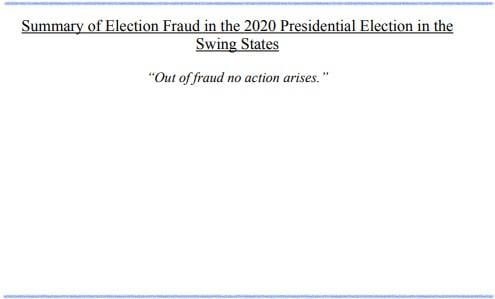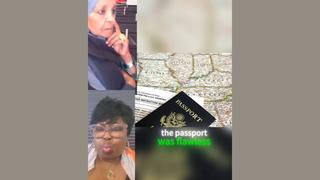
by: Ed Payne and Alexis Tereszcuk
Does a 32-page report shared online in January of 2023 provide proof of widespread 2020 election fraud in five swing states? No, that's not true: The report lacks credible nonpartisan documentation or verifiable data that would substantiate such a sweeping assertion. It promotes a repeatedly disproven assertion that "hundreds of thousands of votes were altered and/or not lawfully cast in the Presidential Election" on behalf of the winner and now-President Joe Biden. Multiple courts have rejected many of the claims. State election officials of both parties have also refuted claims of election fraud.
The claims appeared in a report (archived here) published by an unlisted author or authors on January 2, 2024, titled "Summary of Election Fraud in the 2020 Presidential Election in the Swing States." This is the report's opening paragraph:
It has often been repeated there is 'no evidence' of fraud in the 2020 Election. In actuality, there is no evidence Joe Biden won.
This is how the report appeared online at the time this fact check was written:
(Source: nucleusfiles.com screenshot taken Thu Jan 4 05:25 2024 UTC)
The full report, which was posted online as a standalone PDF, is embedded below:
https://cdn.nucleusfiles.com/e0/e04e630c-63ff-4bdb-9652-e0be3598b5d4/summary20of20election20fraud20in20the20swing20states.pdf
The report
The report is a laundry list of recycled claims that Democrats stole the 2020 presidential election from then-President Donald Trump. It includes more than 140 bullet points alleging that "investigations across the country have uncovered an avalanche of irregularities, unlawful activity, manipulation of election records, destruction of evidence, and fraud."
The report's observations are broken down state-by-state and our analysis will take the same approach. This fact check addresses the major claims made by the report, but not every claim.
Georgia
Report, page 6:
'Thousands of bogus votes' were ultimately added into the Election results via the second machine count. This includes 20,977 unsubstantiated votes of unknown origin. The results were missing 17,852 ballot images, and included 3,125 duplicate ballot images that were counted twice.
This is false. The claim about 17,852 missing ballot images was made by a Georgia citizen. Election officials denied that claim to Lead Stories here.
A spokesperson for Georgia Gov. Brian Kemp told Lead Stories that "retelling the same lies for three years does not make them true," adding, "2020 election in Georgia was not stolen."
Fulton County, Georgia, did not count votes that did not exist in the 2020 election and the claim that there are "no records" for votes, such as poll tapes, is also false, as Lead Stories previously debunked here.
Mark Lindeman, policy and strategy director at the election watchdog Verified Voting (archived here), said that claiming votes are missing because of missing poll tapes is "like telling me my house doesn't exist unless I can find all the bank documents."
The Georgia secretary of state's public information officer for elections, Mike Hassinger, told Lead Stories that "A missing poll tape by itself means nothing about the accuracy and validity of an election, because of the multiple tallies and redundant safeguards we use to ensure election integrity."
Fulton County Communications Division Manager Regina Waller dismissed as "unequivocally false" the assertion that the county added fraudulent votes to the 2020 vote count. The votes in the 2020 general election in Fulton County were counted three times: on election night, in an audit and in a recount, that manager said.
Hassinger explained to Lead Stories via email on December 22, 2023, how Georgia's vote recording works:
The poll tape is one record of votes cast either in a polling location or by a single machine. Sometimes they are not generated (the machine runs out of paper on which to print the tapes, for instance, or they just get lost). But a lack of a poll tape doesn't invalidate a single vote. The counts of which have been recorded on the machine, by the scanners, by the number of ballots given out by the poll workers, in the Statement of Votes Cast, etc. A poll tape is not the only place votes get recorded.
Waller responded by email on December 21, 2023, that the claim is "disinformation":
The Fulton County Department of Registration & Elections maintains that, the assertion that Fulton County added fraudulent votes to the November 2020 election and subsequent recount is unequivocally false, and the claim that over 20k votes were found is disinformation. Multiple audits, investigations, and recounts, including a hand recount of all ballots, confirmed the accuracy, and integrity of the election results in Fulton County. There were also independent audits and investigations by state and local officials, as well as third-party observers, and no evidence of election fraud, discrepancies, nor irregularities that could have affected the outcome of the 2020 election were found.
Wisconsin
From the report, page 13:
The election integrity group True the Vote identified 107 ballot traffickers in Milwaukee County between Oct. 20 and Nov. 3, 2020, who each made 20 or more visits to drop boxes. Each trafficker made an average 26 visits, and as many as 15 in one day, and made multiple visits to non-governmental organizations.
The 107 traffickers made a total of 2,824 trips to drop boxes during the 2020 Election, with a majority of visits occurring after 8:00 p.m.
This is not true. This claim cites True the Vote, a Texas-based conservative group, as the source of the information. True the Vote purchased cellphone geotracking data, covering the period from October 20, 2020, through Election Day on November 3, 2020, in an attempt to show that "ballot traffickers," or "mules" were working with nonprofit groups in what it alleges was a ballot-harvesting operation.
True The Vote bought anonymized data that doesn't directly link cellphone information to the phone's owner. To do that would require a warrant, something the organization wouldn't have access to.
Their report doesn't explain how the people analyzing the data determined whether the people associated with the cellphone signals actually stopped at the ballot drop boxes and nonprofits or just happened to be driving by on the way to work or somewhere else. There was no video surveillance to crosscheck with the geospatial phone data (page 5 of True the Vote report). Additionally, the accuracy of the GPS on a smartphone is limited, according to the ItStillWorks website:
Accuracy to within 10 meters [32.8 feet] can be expected as long as the phone locks on to at least three satellites.
Bottom line: With fewer satellites, the information is less accurate. Ultimately, the data provides no evidence directly linking the cellphone owners to ballot boxes or the nonprofits they allegedly collaborated with.
Pennsylvania
From the report, page 18:
Months after the election, there were 121,240 more votes than voters, according to the Pennsylvania Department of State. By law, Pennsylvania cannot certify an election with this type of discrepancy.
This is false. According to the Pennsylvania Department of State website (archived here), the number of voters who registered for the 2020 presidential election far outnumbered those who cast votes. Voter registration totaled 9,090,962, while 6,915,283 voted.
Lead Stories debunked a similar claim in an earlier fact check that said, "States Did NOT Have More Votes Than Registered Voters."
Arizona
Report, page 22:
Maricopa County accepted 20,500 mail-in ballots after Election Day 2020, including 18,000 - more than the entire election margin - on Nov. 4 picked up from the U.S. Postal Service. By law, ballots must be received no later than 7 p.m. on Election Day, which was Nov. 3.
This is not true. As Lead Stories previously reported here, that false claim is based on the record of when election officials in Maricopa County, Arizona, gave early ballot envelopes to a vendor to be scanned, not a receipt of when election officials first came into possession of the envelopes. Megan Gilbertson, spokesperson with the Maricopa County Elections Department told Lead Stories on June 3, 2022:
We use another company to scan them in because we have so many, and so those are our receipts to say: 'This is what we delivered to you.'
Gilbertson stressed that only ballots received by 7 p.m. MST (9 p.m. EST) on Election Day were counted.
Michigan
Report, pages 28 and 29:
Affidavits and video evidence revealed thousands of ballots were delivered through a back door of the TCF center, the central counting facility in Detroit, at 3:30 a.m. on Election night.
A report seeking to 'debunk' issues of fraud released by the Michigan State Senate Oversight Committee confirmed a 'large volume' of ballots were delivered to the TCF center with no chain of custody in the middle of the night.
That is false. While the report may very well be correct in identifying the objects taken from the van as ballots, it is not correct in asserting that those ballots were illegal. They were legal votes that had been cast before the 8 p.m. Election Day deadline.
Note that the deadline is for casting votes, not counting them. Absentee ballots can arrive at counting boards, such as the TCF Center, after 8 p.m. on Election Day.
Lead Stories reached out to the secretary of state's office in Michigan to ask about the article's claims for a fact check published on February 9, 2021. A spokeswoman wrote back that what took place was "standard and appropriate practice." She pointed us to the office's website (archived here), which offers the following explanation:
In many larger jurisdictions, absentee ballots that arrived on Election Day were marked as received and put through security checks at clerk offices prior to being brought to absent voter counting boards. If a ballot arrived at a clerk's office at 8 p.m., it may not move through the process and be sent to the counting board for several hours. This is why, in cities including Detroit, ballots arrived at counting boards several hours after polling places had closed.
Additional support for the case that the ballots were legal can be found in a sworn affidavit by Christopher Thomas, Michigan's former director of elections. You can read his affidavit here; Thomas' part starts on page 69. Regarding the delivery of ballots to the TCF Center, he wrote:
Ballots are delivered to the TCF Center after they are processed at the Department of Elections main office on West Grand Boulevard. On election day, ballots are received from the post office and the satellite offices. It takes several hours to properly process ballots received on election day.
Thomas continued:
The ballots delivered to the TCF Center had been verified by the Detroit City Clerk's staff prior to delivery in a process prescribed by Michigan law.
He specifically addressed several deliveries, noting the final one, consisting of some 16,000 ballots, took place early in the morning of November 4, 2020. Thomas concluded:
It would have been impossible for any election worker at the TCF Center to count or process a ballot for someone who was not an eligible voter or whose ballot was not received by the 8:00 p.m. deadline on November 3, 2020.
Thomas' account and expertise were cited repeatedly in an opinion from Wayne County Circuit Court Chief Judge Timothy Kenny, who denied a request to delay the certification of election results in a lawsuit that had alleged fraud. Kenny wrote:
Plaintiffs rely on numerous affidavits from election challengers who paint a picture of sinister fraudulent activities occurring both openly in the TCF Center and under the cloak of darkness. The challengers' conclusions are decidedly contradicted by the highly-respected former State Elections Director Christopher Thomas who spent hours and hours at the TCF Center November 3rd and 4th explaining processes to challengers and resolving disputes.
Later in his opinion, Kenny was even more pointed, writing:
Plaintiffs' interpretation of events is incorrect and not credible.
Additionally, the Michigan State Senate Oversight Committee report (archived here) does not confirm that "a 'large volume' of ballots were delivered to the TCF center with no chain of custody in the middle of the night" as the 32-page "Election Fraud" report suggests. The report of the Republican-dominated committee says just the opposite:
Frequent demands to decertify all or a portion of the vote are accompanied by high sounding language regarding the 'chain of custody.' This verbiage evokes images of evidence utilized in trials, such as sealed envelopes and locked evidence rooms with sign-out sheets. However, investigating the claims regarding problems with the chain of custody usually finds highlights about the handling and transmission of the unofficial vote counts and the computer systems used to handle them. While concerns about these systems may be justified, it is incredibly misleading and irresponsible to imply this holds any danger to the official vote counts, the tabulators, or the ballots themselves.
Read more
Other Lead Stories fact checks about U.S. elections can be found here.


















